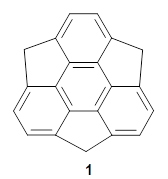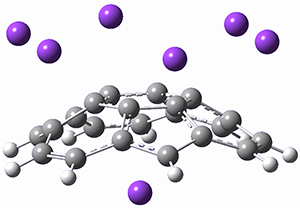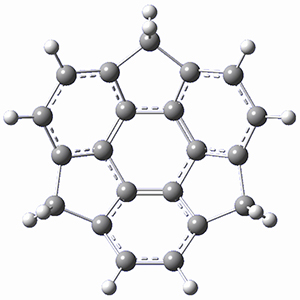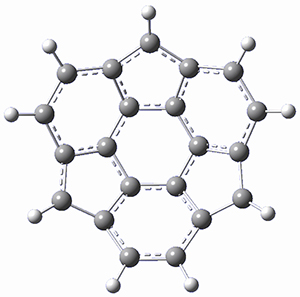Spisak, et al. treated sumanene 1 with excess potassium in THF.1

They obtained an interesting structure, characterized by x-ray crystallography: a mixture of the dianion and trianion of 1 (well these are really conjugate di- and tribases of 1, but we’ll call them di- and trianions for simplicity’s sake). A fragment of the x-ray structure is shown in Figure 1, showing that there is one potassium cation on the concave face and six potassium ions on the convex face.
Figure 1. X-ray structure of 1 surrounded by six K+ ions on the convex face and one K+ on the concave face.
To help understand this structure, they performed RIJCOSX-PBE0/cc-pVTZ computations on the mono-, di-, and trianion of 1. The structure of 1 (which I optimized at ωB97X-D/6-311G(d)) and the trianion are displayed in Figure 2. The molecular electrostatic potential of the trianion shows highly negative regions in the 5-member ring regions, symmetrically distributed and prime for coordination with 6 cations.
|
1 |
trianion of 1 |
Figure 2. Optimized structure of 1 and its trianion.
References
(1) Spisak, S. N.; Wei, Z.; O’Neil, N. J.; Rogachev, A. Y.; Amaya, T.; Hirao, T.; Petrukhina, M. A. "Convex and Concave Encapsulation of Multiple Potassium Ions by Sumanenyl Anions," J. Am. Chem. Soc. 2015, 137, 9768-9771, DOI: 10.1021/jacs.5b06662.
InChIs
1: InChI=1S/C21H12/c1-2-11-8-13-5-6-15-9-14-4-3-12-7-10(1)16-17(11)19(13)21(15)20(14)18(12)16/h1-6H,7-9H2
InChIKey=WOYKPMSXBVTRKZ-UHFFFAOYSA-N
Trianion of 1: InChI=1S/C21H9/c1-2-11-8-13-5-6-15-9-14-4-3-12-7-10(1)16-17(11)19(13)21(15)20(14)18(12)16/h1-5,7-8H,9H2/q-3
InChIKey=IHJVIPHOCKVJDZ-UHFFFAOYSA-N




Henry Rzepa responded on 14 Sep 2015 at 1:32 pm #
Using the publication DOI cited above, one can immediately get an alternative view of the crystal structure, via the link https://summary.ccdc.cam.ac.uk/structure-summary?doi=10.1021/jacs.5b06662 using the page https://summary.ccdc.cam.ac.uk/structure-summary-form. This reveals the role of the the solvent in stabilizing the system, and one might then ask the question of whether a RIJCOSX-PBE0/cc-pVTZ calculation on this more complete (i.e. charge realistic/neutral) system would reveal anything interesting. I note that the crystal structure itself has an assigned DOI: 10.5517/CC14KLKV which takes us to the same display as above. Here we see two DOIs, one for the “story or narrative” and one for the “data” that form a scientific symbiotic. And one advantage is that the data is unlikely to be behind a publisher paywall, unlike the narrative.
Steve has been inserting such 3D models into his blog for years, performing a service that few journals do. Now that alternatives such as the above offer a similar dispensation, we can finally (after in fact 20 years since this concept was first proposed) start getting routine access to the original data in a mode of instant-perception that (IMHO) does really enhance the science. If you do not trust my assertion, go look at the full structure via the links above to see if is indeed valuable to do so.